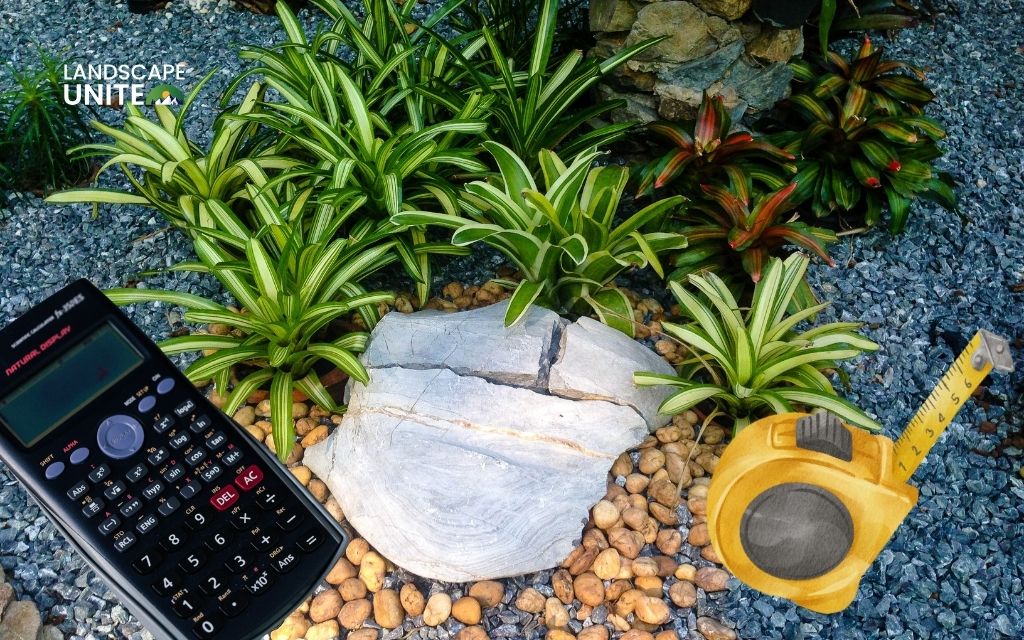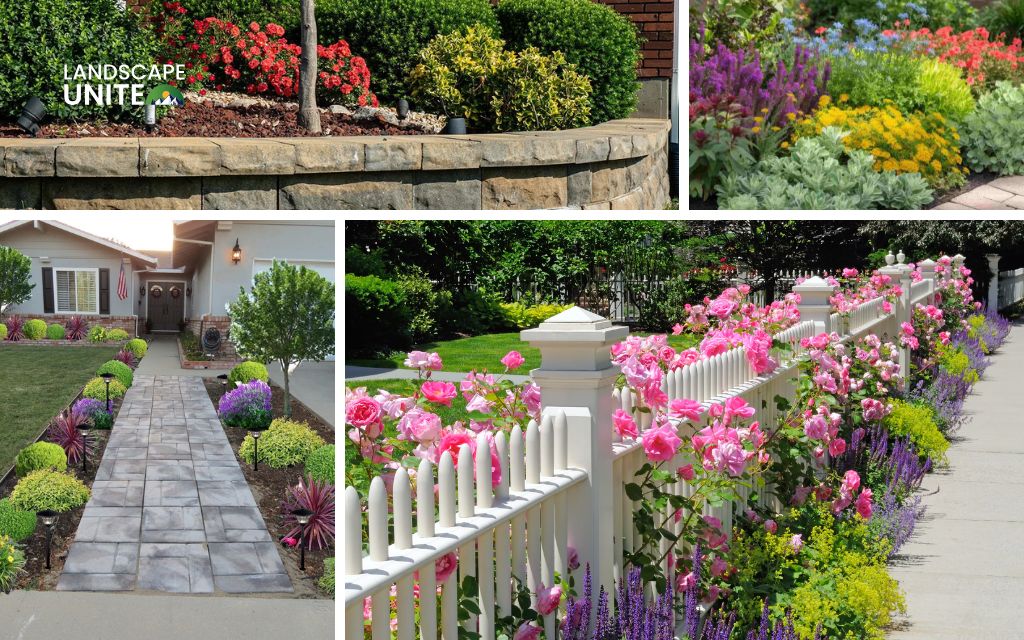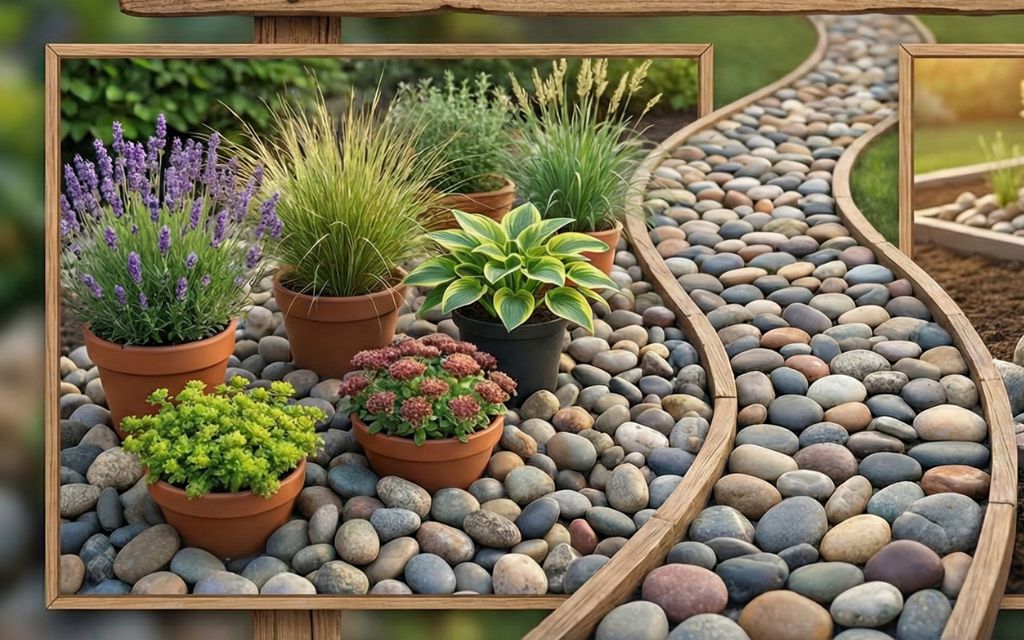When winter strips away summer’s vibrant blooms, your garden doesn’t have to become a barren landscape. Winter flower beds offer an extraordinary opportunity to maintain color, texture, and visual interest throughout the coldest months. These specialized garden spaces combine strategic plant selection with thoughtful design to create outdoor beauty that thrives when most gardens lie dormant. From the cheerful yellow blooms of winter jasmine to the elegant cups of hellebores pushing through snow, winter flower beds prove that cold weather gardening can be both rewarding and spectacular.
This comprehensive guide will walk you through everything needed to design, plant, and maintain winter flower beds that will transform your landscape into a four-season masterpiece, ensuring your outdoor space remains a source of pride and joy even during winter’s harshest days.
Essential plants for winter flower beds
Creating stunning winter flower beds starts with selecting the right plants. Unlike traditional summer gardens, winter landscapes rely on hardy specimens that not only survive freezing temperatures but actually thrive during cold months. The secret lies in understanding which flowers bloom in winter and how to combine them for maximum impact.
Hardy perennials that define winter beauty
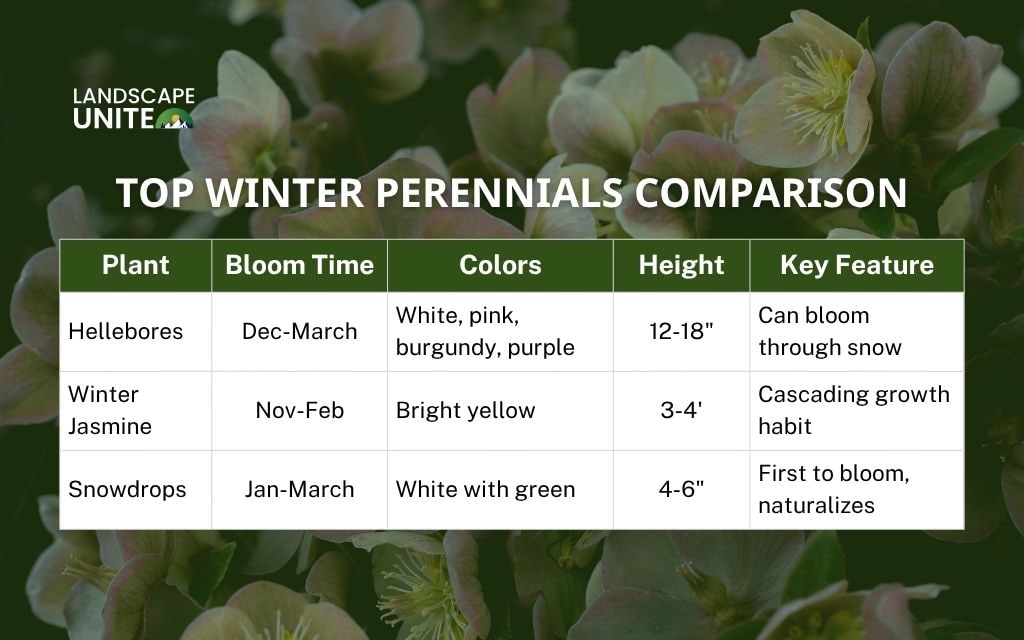
Hellebores are the backbone of winter flower beds. These remarkable perennials can bloom through snow cover and self-seed over time, creating larger colonies each year. They prefer partial shade and well-draining soil. Position them near windows to maximize visual impact during months when outdoor time is limited.
Winter jasmine brings bright yellow blooms when you need them most. This low-maintenance shrub features cascading branches perfect for slopes or walls. The flowers appear on bare stems from November through February, creating stunning contrast against snow.
Snowdrops are often the first flowers blooming in snow, appearing as early as January. Plant them in large drifts for impact. These hardy bulbs tolerate temperatures well below freezing and multiply freely over time.
Cold-weather annuals for continuous color
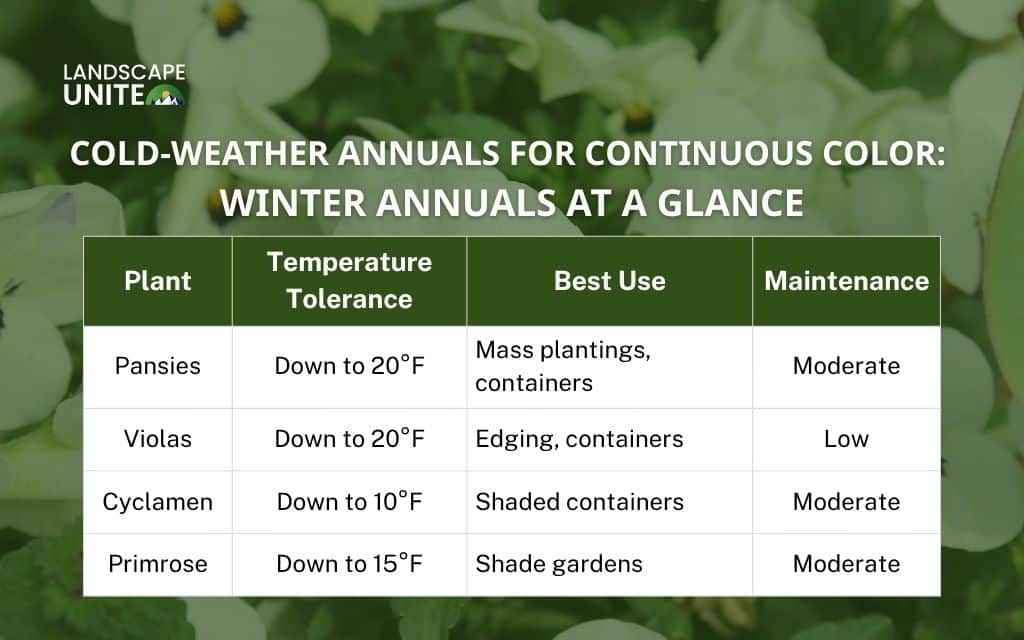
Pansies and violas are reliable winter bloomers that continue flowering throughout cold months. They provide crucial color during gray winter days and work perfectly in both ground plantings and winter container flower bed arrangements.
Cyclamen thrives in cooler temperatures between 40-50°F. Hardy outdoor varieties survive down to 10°F when properly mulched. They prefer moist but never soggy soil and protection from harsh winds.
Primroses burst into bloom in late winter, bridging the gap to spring. They prefer rich, moisture-retentive soil and partial shade, creating vibrant patches of color in virtually every hue.
Structural elements for year-round interest
Structural plants role
| Type | Purpose | Examples | Winter Interest |
| Ornamental Grasses | Movement, texture | Fountain grass, Switchgrass | Seed heads, golden foliage |
| Evergreen Shrubs | Structure, backdrop | Boxwood, Holly, Dwarf conifers | Year-round greenery |
| Berry Producers | Color, wildlife food | Winterberry holly, Pyracantha | Bright berries |
These structural elements become more visually prominent as other plants go dormant, making them invaluable for winter flower beds. They provide the framework that showcases flowering plants while looking attractive on their own.
Designing your winter flower bed layout
Strategic design ensures your winter flower beds deliver maximum impact throughout the coldest months.
Site selection essentials
Winter sun angles differ from summer. Observe potential sites during December and January to understand actual winter light conditions. Most flowers that grow in the winter need 4-6 hours of sunlight daily.
Critical site factors
| Factor | Requirement | Why It Matters |
| Sunlight | 4-6 hours daily | Powers winter blooms |
| Drainage | Water disappears in 4 hours | Prevents freeze damage |
| Soil pH | 6.0-7.0 | Optimal nutrient availability |
| Protection | Some wind shelter | Extends bloom times |
Test drainage by digging a 12-inch hole and filling it with water. If water remains after 4 hours, improve drainage before planting. Even a 6-inch raised bed makes significant difference in plant survival.
Creating visual impact
Garden layering structure
| Layer | Height | Plant Types | Examples |
| Background | 36+” | Tall shrubs, grasses | Evergreens, ornamental grasses |
| Midground | 12-36″ | Medium perennials | Hellebores, winter jasmine |
| Foreground | Under 12″ | Low plants, bulbs | Snowdrops, violas |
Layer plants in three zones: background, midground, and foreground. This tiered approach creates depth that makes gardens feel established and professional.
Effective winter color combinations
| Primary Color | Pair With | Effect |
| Yellow | Purple, white | Cheerful, energizing |
| White | Green, burgundy | Clean, elegant |
| Purple | Yellow, pink | Rich, sophisticated |
Position brightest colors where they’re visible from frequently used rooms. Limit your palette to 3-4 complementary colors for sophisticated unity.
Seasonal succession planning
Winter bloom timeline
| Period | Featured Bloomers | Design Tips |
| Early Winter (Dec-Jan) | Winter jasmine, Early hellebores | Place in prominent locations |
| Mid Winter (Jan-Feb) | Peak hellebores, Snowdrops | Layer with evergreens |
| Late Winter (Feb-Mar) | Late hellebores, Primroses, Crocus | Integrate spring bulbs |
Plant spring bulbs among winter flowers during fall installation for continuous color from December through May.
Planting and establishment techniques
Successful winter flower beds begin with proper timing and technique.
Timing your installation
Planting schedule by zone
| Climate Zone | Best Planting Window | Last Safe Date |
| Zones 7-9 | Sept-Nov | Late November |
| Zones 5-6 | Aug-Early Oct | Mid-October |
| Zones 3-4 | Aug-Sept | Early September |
Plant between August and October depending on your zone. This allows roots to establish before ground freezes, giving plants the stability needed to survive winter and bloom successfully.
Soil preparation essentials
Soil amendment guide
| Amendment | Amount | Primary Benefit | When to Apply |
| Compost | 3-4 inches | Improves structure, nutrients | Fall, before planting |
| Coarse Sand | 2 inches | Drainage in clay soils | Fall, before planting |
| Mulch (after planting) | 2-3 inches | Prevents heaving | After ground freezes |
Incorporate 3-4 inches of compost into the top 12 inches of soil. Apply 2-3 inches of mulch after the ground freezes, keeping it away from plant crowns to prevent rot.
Maintenance throughout winter
Winter flower beds require different care than summer gardens.
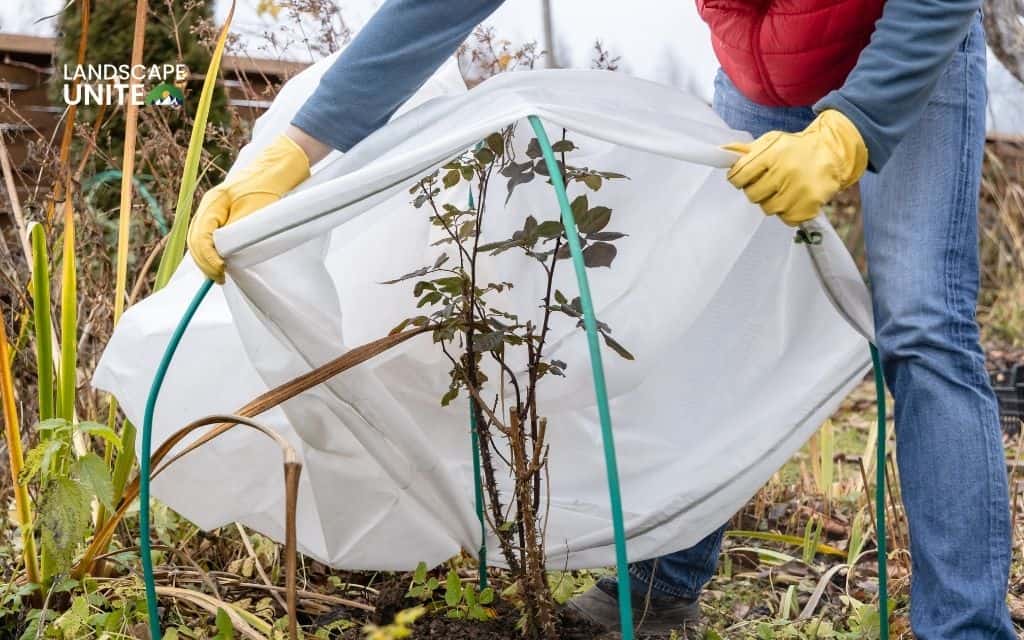
Protection and watering
Winter protection quick reference
| Method | When to Use | Effectiveness |
| Frost Cloth | Sudden cold snaps | 2-8°F protection |
| Mulch Layer | Season-long | Prevents heaving |
| Building Placement | Extreme cold | Creates warmer microclimate |
| Snow Brushing | Heavy wet snow | Prevents breakage |
Water when soil isn’t frozen and you’ve had two weeks without precipitation. Apply during the warmest part of the day. Container gardens need weekly moisture checks.
Monthly winter care
| Month | Key Tasks | Priority |
| November | Apply winter mulch after hard freeze | High |
| December | Check containers, brush heavy snow | Medium |
| January | Monitor damage, maintain containers | Low |
| February | Light feeding of bloomers, plan spring | Medium |
| March | Remove mulch, resume regular care | High |
Troubleshooting common problems
Quick problem solutions
| Problem | Signs | Solution |
| Frost-damaged buds | Brown, mushy buds | Remove damaged blooms only |
| Heaved plants | Exposed roots | Press back gently, add mulch |
| Aphids | Clusters on growth | Spray with water or insecticidal soap |
| Voles/Rabbits | Chewed stems | Install hardware cloth barriers |
| Poor drainage | Standing water | Create raised beds, improve soil |
Most issues can be prevented through proper site selection and plant care. Keep a garden journal noting what works in your specific conditions.
For detailed pest management strategies, check our comprehensive guides on Landscape Unite.
Transitioning to spring
The best winter flower beds seamlessly transition into spring.
Seasonal succession strategy
| Plant Type | Planting Time | Bloom Time | Purpose |
| Spring Bulbs | Fall (Sept-Nov) | March-May | Bridge to spring |
| Early Crocus | Fall (Sept-Oct) | Feb-March | Late winter color |
| Spring Perennials | Fall or early spring | April-June | Take over as winter fades |
Plant spring bulbs at different depths: tulips 8 inches, daffodils 6 inches, crocus 3 inches. This creates waves of bloom throughout the transition period.
Spring cleanup timing
| Task | When | Method |
| Remove winter mulch | New growth appears | Pull back gradually |
| Cut ornamental grasses | Late winter | Cut 2-4″ from ground |
| Remove spent annuals | As they fade | Pull entire plant |
Wait for definite new growth before cleaning up. Many plants that look bedraggled rebound beautifully once temperatures warm.
Conclusion
Creating spectacular winter flower beds transforms the coldest months into a season of garden beauty and anticipation. By carefully selecting hardy plants, implementing proper design principles, and maintaining consistent care, your landscape can provide year-round enjoyment and curb appeal. These winter gardens serve as crucial wildlife habitats, providing nectar sources when few other plants are flowering, while maintaining property value through every season.
Ready to transform your winter landscape? Whether you’re starting your first winter flower beds or enhancing existing plantings, the key lies in understanding each plant’s unique requirements and combining them thoughtfully. Take action today by assessing your property for potential planting sites and making plans for fall installation.
Landscape Unite serves as your comprehensive resource for gardening and landscape inspiration, offering expert guidance for every season and every garden challenge. Contact Landscape Unite today for more expert gardening tips and discover new posts on our blog to keep your landscape beautiful all year long!
FAQs about winter flower beds
What flowers bloom in winter and can survive freezing temperatures?
Hardy winter bloomers include hellebores, winter jasmine, snowdrops, pansies, and cyclamen, all capable of surviving and thriving in freezing conditions. For professional help selecting plants specific to your climate, contact Mile High Lifescape for personalized recommendations.
When should I plant winter flower beds for best results?
Plant winter flower beds in late summer to early fall (August through October) to allow root establishment before cold weather arrives. This timing ensures plants develop the stability needed to survive winter and bloom successfully.
How do I protect winter flower beds from harsh weather?
Use proper mulching, frost cloth covers, strategic placement near windbreaks, and appropriate watering techniques to protect plants during extreme weather. Learn more protection strategies in our seasonal garden care guides on Landscape Unite.
Can winter flower beds work in very cold climates like zones 3 through 5?
Yes, by selecting extremely hardy plants like hellebores, ornamental grasses, and evergreen shrubs, combined with proper protection methods. Focus on plants proven hardy in your specific zone for best results.
What’s the difference between winter flower beds and regular gardens?
Winter flower beds specifically focus on plants that provide interest during cold months, emphasizing structure, evergreen elements, and cold-weather blooms rather than warm-season flowers. They’re designed to peak when traditional gardens go dormant.
